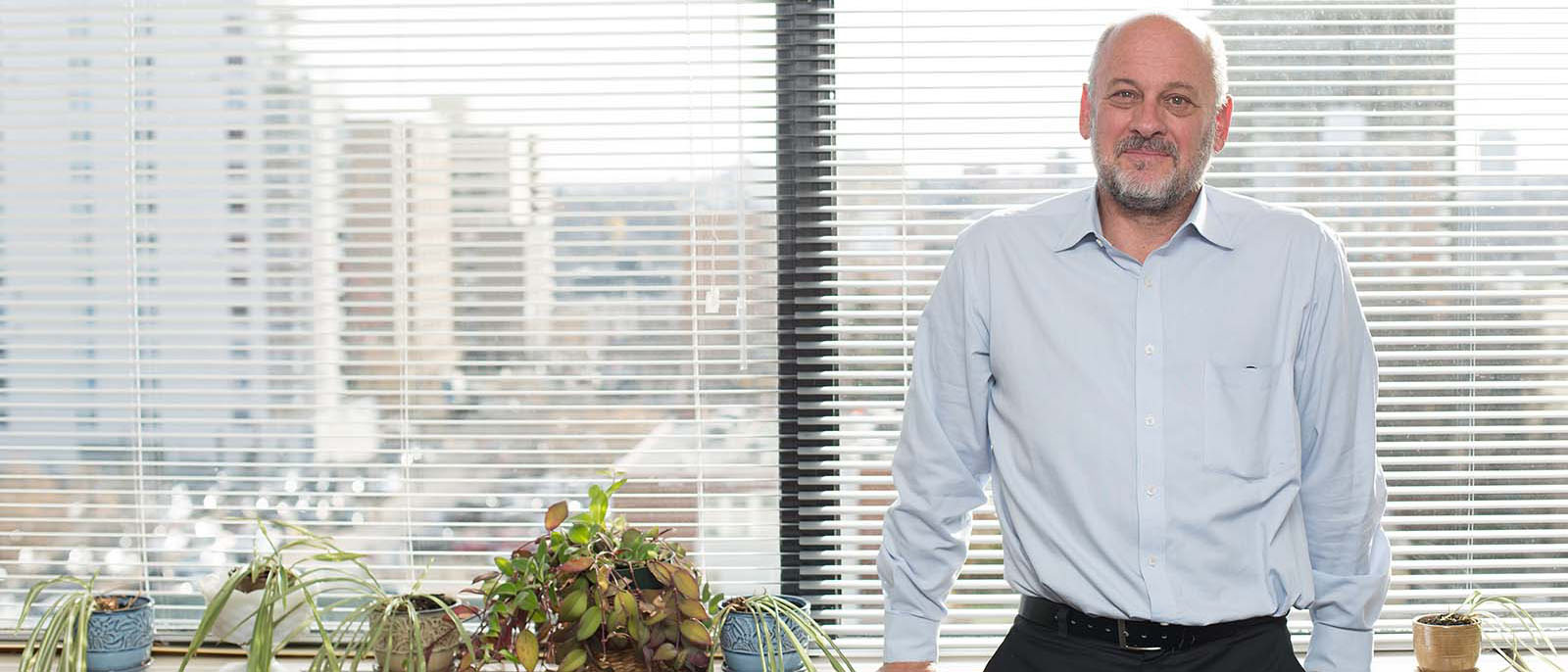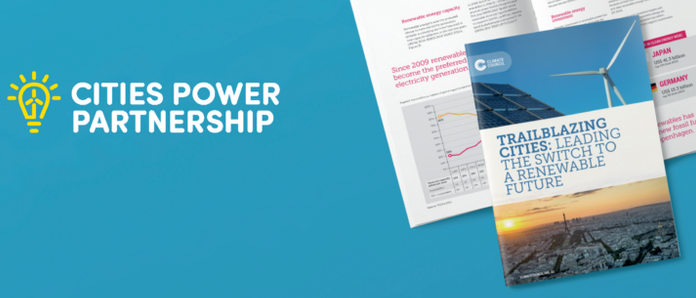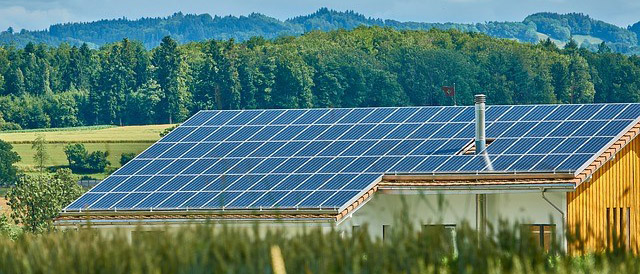Cities of hope: Tim Flannery on tackling the challenge of climate change
In an address to the Melbourne Sustainable Society Institute, the award-winning author and scientist describes why, in the face of seemingly unstoppable global warming, cities could offer our best chance of averting catastrophe.

Our understanding of the way the Earth’s system works has grown significantly over the past decade. Earlier this year, scientists published an equation called the Anthropocene Equation. For the past four billion years, the factors that have affected the Earth’s climate are listed in that equation. They are the astronomical forces, the geophysical forces, and the internal dynamics of the system. But over the past 40 years, we must add another factor into that equation, which is the H factor – the human factor. Because of that factor, the impact of industrialised societies, we are now driving Earth’s climate system at rates 170 times faster than the natural factors have done, historically. So, H is big. We are a big influence, now, on Earth’s climate system.
Why are we such a big influence? Because we are shifting so much carbon from the Earth’s crust into the atmosphere. The atmosphere is one of the smaller organs of our planet – it’s about 1/500th the size of the oceans. So, it’s small, and very dynamic, and we are moving lots of carbon into it. As of 2010, we are emitting 49 gigatons of CO2 equivalent every year. Data that has just come out for 2016 shows that, in fact, emissions have grown again, by about three percent. So, we are well in excess of 50 gigatons of CO2 equivalent now.
Our understanding of the way the Earth’s system works has grown significantly over the past decade. Earlier this year, scientists published an equation called the Anthropocene Equation. For the past four billion years, the factors that have affected the Earth’s climate are listed in that equation. They are the astronomical forces, the geophysical forces, and the internal dynamics of the system. But over the past 40 years, we must add another factor into that equation, which is the H factor – the human factor. Because of that factor, the impact of industrialised societies, we are now driving Earth’s climate system at rates 170 times faster than the natural factors have done, historically. So, H is big. We are a big influence, now, on Earth’s climate system.
Why are we such a big influence? Because we are shifting so much carbon from the Earth’s crust into the atmosphere. The atmosphere is one of the smaller organs of our planet – it’s about 1/500th the size of the oceans. So, it’s small, and very dynamic, and we are moving lots of carbon into it. As of 2010, we are emitting 49 gigatons of CO2 equivalent every year. Data that has just come out for 2016 shows that, in fact, emissions have grown again, by about three percent. So, we are well in excess of 50 gigatons of CO2 equivalent now.
How big a figure is that? If you think about it in terms of human beings, we all have a rough idea of how much we weigh. If you put all of us into the atmosphere, twice over, you would still struggle to reach 50 gigatons. It’s a big, big number. How many trees would you need to plant to take one tenth of that flow of 50 gigatons out of the atmosphere? You would need to plant all of the US in forest, including Alaska, to get, in approximate figures, close to five gigatons, or one tenth of the total.
We are well in excess of 50 gigatons of CO2 equivalent now... If you put all of us into the atmosphere, twice over, you would still struggle to reach 50 gigatons. It’s a big, big number.
So, they’re very, very big numbers that we’re talking about. It’s important to keep that in mind, as we start thinking about the cumulative impact of all that CO2, and the opportunities we face.
So, what are the impacts of this huge flow of carbon into the atmosphere? Scientists have been studying impacts extensively now, for many decades, and have detected climate impacts in every ecosystem on the planet. Some parts of our planet, however, are seeing impacts more severe than others. The coral reefs of the world, particularly, are suffering from coral bleaching. As of today, 70 to 80 percent of the coral on the Great Barrier Reef is dead. The Great Barrier Reef yields about $6 billion worth of income for Australia, through tourism and fisheries, and so forth. It also protects that coast from coastal erosion. As that is lost, we will add economic cost to the environmental damage that we do.
Things closer to the hearts of some of us are also at stake. Over the past few years in south-eastern Australia, for example, grape growers have had to invent a form of sunscreen for their grapes, to stop the grapes from getting sunburned. They have also seen their ripening advance by about a month and are finding that the grape varietals that they’ve planted aren’t suitable to a new climate. In some areas, they’re getting serious damage from smoke taint, as bush fires increase.

After 21 years of arguing about all of this, the world finally came to an agreement in April 2016, called the Paris Agreement. The central aim of the Paris Agreement is to keep global temperatures from rising more than two degrees Celsius this century – and, if we can, to limit temperature increases to as little as 1.5 degrees Celsius. They are very, very ambitious targets. The actions taken initially, under the Paris Agreement, are enough to limit temperature rises to somewhere between three and four degrees, so we’ve got a long way to go to reach the target figures.
The factor that will determine the success of the Paris Agreement is the global carbon budget. The latest studies to be done in this area suggest that we are going to be in serious trouble staying below two degrees. In fact, some scientists think we have already emitted enough CO2 to carry us through two degrees of warming. We have to cut those emissions, as hard and fast as we possibly can. What we have had this year is an announcement that CO2 is now accumulating in the atmosphere, at a faster rate than ever in recorded history. We are now looking at 3.5 parts per million increase last year. That’s huge.
I want to launch in with why the Climate Council, in this milieu, has decided cities are the way to go. It’s no secret that a lot of us are sick to the back teeth with inaction by the federal government. We have identified that cities are where the Council can get the most traction, and start getting some work done. The realisation that cities can deliver 70 percent of total emissions reductions required was important for us. This is where a lot of the energy that we get from fossil fuels is expended. If we can transform the way cities transport, and energy systems operate, we can have a huge impact and help stay on track for the two-degree limit.
If we can transform the way cities transport, and energy systems operate, we can have a huge impact and help stay on track for the [Paris Agreement] two-degree limit
There has been a lot of action in the cities area recently. At COP 23, the World Bank announced a new program that’s designed to provide cities with a vehicle for raising necessary funding and investments, to partner with private enterprise. As Christiana Figueres put it in one of the conference’s key financial decisions, she said that the finance to get that urban change will start with a current industry target of US$1 trillion, with more green bonds to come by 2020. It is substantial funding. If we can put Australia’s cities and councils in a favourable position to start getting at least some of that funding, we will see great things happen.
At COP 21, we got some inkling of the appetite that cities have for change. 1000 mayors got together at the Paris meeting to support the two degrees Celsius target. The reason that they’re doing this isn’t purely philanthropic. Cities are facing many substantial problems, whether it be air quality, energy costs, transport congestion – the solutions to which exist in addressing climate change.
Let’s have a look at some of the leading cities around the world, and what’s happening.
San Francisco, in California, is working toward 100 percent renewable electricity, and a mandatory renewable energy target on new buildings, as part of its strategy. As Al Gore said when he was here in Melbourne earlier in the year, one of the most important things any of us can do is set a target. Because unless you set a target, and an ambitious one, you won’t get anywhere.
To source 100 percent of your residential electricity, and 90 percent of the commercial electricity, from renewable sources by 2025 is a real stretch target for a city like San Francisco. And yet, they seem set to achieve that. They’re going to be improving energy efficiency, reducing reliance on gas for electricity generation, shifting 50 percent of their trips to public transport or active transport, like walking or cycling, and shifting all busses, taxi fleets and electric vehicles to renewable energy power by 2030. Last year, the city established a new law, requiring all commercial and residential buildings to install solar panels, solar hot water, or a combination of those technologies, on new build.
Vancouver is also in the vanguard. They are implementing what they call the Greenest City Plan. It focuses on zero carbon, zero waste, and healthy ecosystems. A holistic approach. If any of you have been to Vancouver, there are carpools that exist, almost on every suburban block. If you want a car, you dial a number. You get an SMS message about where your nearest car is. You go there, jump in, drive the car to wherever they want to go to, drop it off, and someone else uses it next time. It’s an incredibly well-developed system of carpooling and car-sharing. When it comes to renewable energy, Vancouver is aiming to derive 100 percent of its energy from renewable sources by 2050. So, a longer timeframe than San Francisco, but still quite ambitious. They want to reduce their greenhouse gas emissions by 80 percent below 2007 levels, before 2050.
The third example is not just a city, but a prefecture, a province in Japan. Fukushima was devastated by an earthquake and tsunami, and it has pledged to aim for 100 percent renewable energy by 2040. They lost their nuclear plant and are now going all out for renewable energy. Why are they doing that? Again, self-interest is part of the answer. In addition to building solar power stations, they are developing a new form of offshore wind energy, which involves floating platforms, with enormous turbines on them. This has done several things. One is that it is giving them propriety interest in a new technology that is widely applicable. Secondly, it’s unlocking a huge energy source for a rather energy-poor country, because they’ve got lots of coastline. And thirdly, it’s adding to local industry, because these steel units are very large, and must be manufactured locally.

With all of this, what is the little old Climate Council in Australia doing, looking at these great global shifts? The truth is that since our founding, back in 2013, we have been effectively an educational group. That’s what we try to do – make sure people understand what’s at stake, what’s happening with our climate, what the opportunities are. But last year, we realised that we needed to accelerate action, and we looked around for where we could best do that. Cities were the area that we settled on. Alix Pearce has been Director of our Cities Power Partnership ever since.
Earlier this year, we launched the program in Canberra. To give you an insight into how this works: we had a lunch after the launch, at Parliament House. I was sitting at one of the tables with mayors from various parts of the country and there was an incredible energy. One guy was saying, “In our council,” which was up on the Central Coast, “We’re making our own sustainable asphalt. Recycled asphalt.” Someone said, “My god! What a brilliant idea! Can you tell us how to do that?” Someone else was saying, “We’ve put solar panels on 500 homes in our area, for people who are suffering energy poverty.”
Getting people in the room together, on that day, was one of the most inspiring things that I’ve been involved with. It was just fantastic to see the energy flow, and to see that we could build structures that would help people share ideas, save money, and get better, greener outcomes.
The Council’s partners are from all around the country, big and small. Some, with hardly any staff who have any experience in clean energy. Others include world leaders in clean energy deployment. Australian cities are really playing their part. We’ve seen 100 percent renewable energy and zero emissions examples from Canberra, Sydney, Melbourne, Adelaide, as well as many smaller councils, like Byron Shire, Uralla, Yackandandah and Lismore. So, why are they doing this? A lot of it is self-interest. I talked to Bathurst’s Mayor some years back. He was saying, “We must spend A$25 million a year on energy costs in our region. That’s money that’s leaving our community, and going to head offices of big multi-national companies in Canberra, Melbourne, or even overseas.”
On a smaller, island scale, you see it even more. People in places like Vanuatu say when a diesel tanker pulls up and fills up their diesel generator reserves, that’s when the money goes out of the community. They actually see it leave. It’s fortunate, in a way, they see that. In our regional communities, it takes a bit of thinking to understand that that money leaves the community, when it could be there, paying for the generation of electricity locally, saving money, and making sure that the local economy is more robust, resilient and wealthy.
Places like Canberra are leading in this. They have had some of the best thinkers in Australia aiming at their 100 percent renewable electricity target, by 2020. Which, incidentally, they’re on track to achieve. They are only just over two years out, now, but they’re going to get there. And a net zero emissions target by 2050, at the latest. One in nine Canberra households already have rooftop solar, and the number just continues to grow. There are more solar panels in Australia now than there are people.
There are more solar panels in Australia now than there are people
An example from Victoria: the Moreland electric vehicle charging network. This network of publicly available electricity charging stations includes the first fast-charge station in the country that can charge your electric car in 40 minutes. It’s free use, to encourage wider uptake of zero-emissions modes of transport, and electric battery charging is available also, at the Moreland Civic Centre. These are the sort of things that, once you start putting councils in touch with each other, and they can see and learn precisely how it’s done, you start getting some great changes.
Also in Victoria: the Darebin Solar Savers Program. This was one that created huge interest at our initial meeting in Canberra. Darebin is in Melbourne’s northern suburbs. They’ve got a zero-net emissions target by 2020. The Solar Savers Program was really put in place to allow pensioners and other lower households, and not-for-profit organisations, to become solar power owners, to reduce their electricity bills. It’s a zero-interest financing scheme. The city pays up front, for the panels to be installed, and gets the money back over 10 years, through small additional charges to land rights.
The second round of the Solar Savers initiative worked with specifically low-income social housing renters, and the cost of the panels was recouped through a small rent increase. Close to 500 properties, and nine community centres, have participated so far, since 2014, with over 1000 kilowatts of photo-voltaics installed. If we talk about energy, poverty, and people under stress, what a simple thing to do. Why isn’t everyone who is responsible for social housing in the country, doing something like this?

The Strathbogie Shire – not Australia’s largest council I hasten to add – probably one of the smallest, but doing some interesting stuff. With the Solar Panel Bulk Program, they are putting in nearly 400 kilowatts in 15 weeks, and the savings for that local community are on the order of $176,000 per annum. That’s money staying in the community.
Queensland’s Logan City also has an interesting program. They’re looking at a water treatment plant servicing 200,000 people, powered by a Tesla solar battery and 300-odd solar panels. That system will be supplying water to people 24 hours a day, for residents. Water treatment is a big, new area for councils to look at for energy savings. It costs a lot to pump water, because it’s heavy stuff, and to purify it. So, clean energy resources are a very cost-effective and useful way of dealing with water issues.
Those sort of things are what we’re trying to synergize. We asked those councils to put forward four actions. We asked them to form a partnership with three or four other councils, including councils from other states, because there is very little inter-state linking across our council areas. And to be accountable, report back, and take action.
The biggest barriers we have, when we think about these stretch targets of 100 percent renewables by 2025, are in our head
The biggest barriers we have, when we think about these stretch targets of 100 percent renewables by 2025, are in our head. When we think about 2050, and what we need to achieve by then, let’s think back a century to 1917. In just 32 years’ time from the end of 1917, there would be no more horses in the streets. How would you explain to a university student, that they could be flying through the air, just 32 years on? That’s the challenge for us between now and 2050: to create enough imaginative space to see the solutions. Our little tiny Climate Council saw an opportunity with this partnership. People want to be part of it. They want to succeed, and they see the project that we have put forward as helping them do that; empowering them.
It’s just one small measure that’s going to be required between now and 2050, but we are very, very proud of it.
This is an abridged and edited extract of a talk given by Tim Flannery on 20 November 2017 at the University of Melbourne. The full talk can be viewed below:
Author
Professor Tim Flannery
Professorial Fellow, Melbourne Sustainable Society Institute
This article was originally published by Foreground